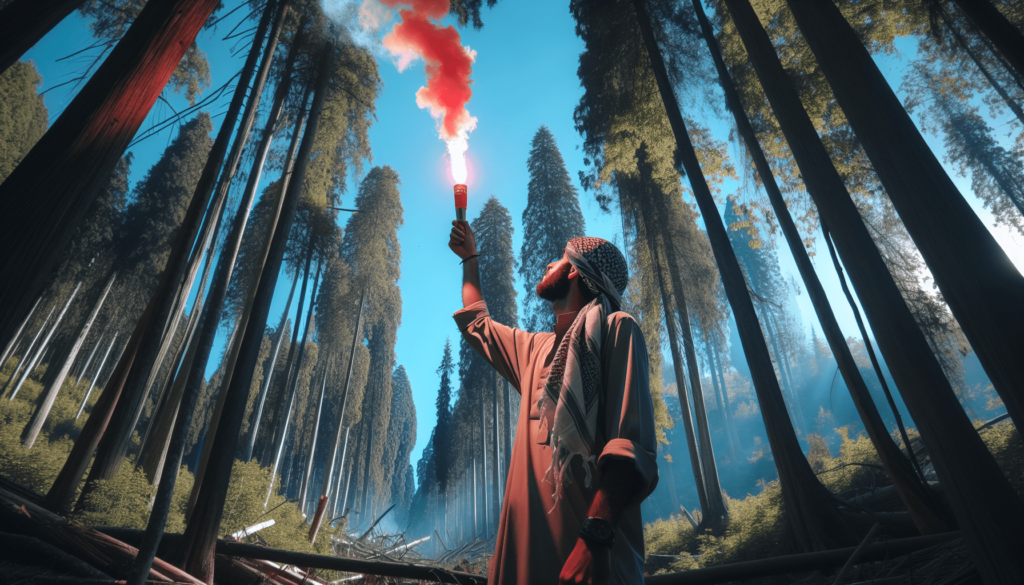How to Signal for Help in the Wilderness” guides you through essential techniques to ensure your safety when you’re far from civilization. You’ll discover practical methods to attract attention using tools you already carry, along with ingenious tricks to utilize natural resources. Whether you’re a seasoned adventurer or new to outdoor exploration, this article equips you with vital knowledge to stay safe and be found, ultimately turning potential peril into another memorable outdoor experience. Dive in now, and empower yourself with the confidence to handle any wilderness situation! Have you ever wondered what you would do if you found yourself stranded in the wilderness, far from civilization, and in need of help? Being adventurous can take you into some incredible places, but it’s always important to be prepared for the unexpected. Knowing how to signal for help can be essential in these situations, potentially saving your life or others’.
Title: How To Signal For Help In The Wilderness

Why Knowing How to Signal for Help is Crucial
When you’re out in the wild, it’s easy to become disoriented or face unforeseen challenges. Whether you’re an avid hiker, camper, or just someone who enjoys the occasional outdoor adventure, being aware of different ways to signal for help is crucial.
The Importance of Being Prepared
Preparation is key to any successful expedition. Always bring a basic signal kit, stay informed, and have a plan in place in case things go wrong. This small level of preparedness can make a significant difference.
Basic Principles of Signaling for Help
Understanding the principles behind effective signaling can help you get the attention of rescuers or passersby more efficiently.
Visibility and Clarity
The primary goal of any signal is to be seen or heard. This involves making signals as visible and clear as possible. Use bright colors, loud sounds, and high-contrast markings to ensure you stand out against your surroundings.
Consistency and Repetition
Repetition is crucial in making sure your signals are noticed. Consistent, repetitive signals are more likely to catch someone’s attention than a single, fleeting attempt.
Common Methods to Signal for Help
Visual Signals
Visual signals can be highly effective, especially during daytime. There are several methods to create visible signals that can be seen from afar.
Fire and Smoke
Fire is one of the most effective signaling tools in the wilderness. A fire can produce light and, if you add green leaves or wet material, it can create thick smoke.
Steps to Create a Signal Fire:
- Choose a safe location, away from trees and other flammable materials.
- Build a teepee structure with small sticks and add kindling inside.
- Ignite the fire and continuously feed it to keep it burning brightly.
- Add green leaves or wet branches to generate smoke.
Signal Mirrors
A signal mirror can reflect sunlight toward potential rescuers. While this method works best on clear, sunny days, it can be highly effective.
Using a Signal Mirror:
- Hold the mirror in one hand and extend your other arm out.
- Reflect sunlight onto your hand, and then move the reflection in the direction you want to signal.
- Oscillate the mirror back and forth to create a flashing effect.
Ground-to-Air Signals
Using materials available to you, create large symbols on the ground that can be seen from the air.
Common Ground-to-Air Signals:
| Symbol | Meaning |
|---|---|
| V | Require Assistance |
| X | Need Medical Help |
| -> | Moving in this Direction |
Use large, contrasting materials like rocks, logs, or even colorful clothing to create these symbols.
Auditory Signals
Sound travels far and can be heard even when visual signals are not visible due to thick foliage or other obstacles.
Whistles
A whistle can be heard much farther than a human voice and requires less physical effort.
Standard Whistle Signals:
| Number of Blows | Meaning |
|---|---|
| Three | Emergency/Help |
| Two | Come Here/Attention |
| One | All Clear |
Always repeat the signal after a short pause to ensure it gets noticed.
Shouting
If you don’t have a whistle, shouting can be another way to get attention, though it requires more energy and may not be as effective over long distances.
Tips for Shouting for Help:
- Use consistent phrases like “Help!” or “SOS!”
- Pause between shouts to listen for responses.
Using Technology to Signal for Help
Cell Phones and Satellite Devices
Modern technology offers advanced means to signal for help, but it has limitations like battery life and service availability.
Cell Phones
While not always reliable, cell phones should always be the first option if you find yourself in a distressing situation.
Steps to Signal for Help via Cell Phone:
- Check for available service by moving to higher ground if necessary.
- Call or text emergency services (911 in many countries).
- If available, use a location-sharing app to provide your precise coordinates.
Satellite Phones and Personal Locator Beacons (PLBs)
If you’re exploring remote areas, consider carrying a satellite phone or a personal locator beacon (PLB). These devices can signal for help even when traditional cell service isn’t available.
How to Use a PLB:
- Activate the device by following the manufacturer’s instructions.
- The PLB sends a distress signal with your location to emergency responders.
GPS and Mapping Apps
Many mapping apps have SOS features that can help signal for help or track your location. However, they rely on having a charged device and, in some cases, internet access.
Using GPS to Signal for Help:
- Open your GPS app and navigate to the SOS feature.
- Send your coordinates to emergency services or a trusted contact.

Using Natural Resources
Creating Distinctive Patterns
In the wilderness, you can use rocks, branches, or anything you can find to create patterns or symbols that stand out.
Patterns on the Ground
Create patterns like large arrows or distress symbols (SOS) on the ground. The contrast between the pattern and the surrounding environment can catch the eye of rescuers.
Steps to Create Ground Patterns:
- Collect materials that are different in color or texture from the ground.
- Arrange these materials into noticeable patterns.
- Ensure the pattern is large enough to be seen from high altitudes.
Reflective and Colorful Objects
Anything reflective or brightly colored can be used to catch attention. This includes items like foil blankets, brightly colored clothing, and even shiny objects like soda cans.
Tips for Using Reflective/Colorful Objects:
- Hang them in areas where they can catch sunlight.
- Place them in open areas to be more visible.
- Use them in conjunction with other signals for a better chance of being noticed.
Situational Tips for Different Terrain
Forested Areas
Dense forests can make it more challenging to signal for help, but there are effective methods you can use.
Tips for Forested Areas:
- Use fire to create smoke signals.
- Create loud noises, using whistles or shouting.
- Reflect sunlight through small breaks in the canopy with a mirror.
Open Fields and Meadows
In open areas, you have more options for visual signals.
Tips for Open Fields:
- Create large ground signals using contrasting materials.
- Use signal mirrors to reflect sunlight.
- Set up brightly colored fabric or objects at the highest point visible.
Mountainous and Rocky Terrain
High altitudes can affect both visibility and sound. However, the altitude can also help you get a signal out further.
Tips for Mountainous Terrain:
- Climb to the highest safe point for better visibility.
- Use auditory signals like whistles, which can carry far.
- Create large symbols on the ground where they can be seen from the sky.
How to Maximize Your Chances of Being Found
Combine Multiple Methods
Using multiple signaling methods increases your chances of being found. Think of it as a layered approach—visual signals, auditory signals, and technology combined make you harder to miss.
Combination Ideas:
- Use a whistle while simultaneously creating ground patterns.
- Build a signal fire and use a signal mirror.
- Utilize a PLB while marking your location with ground symbols.
Stay Calm and Consistent
Panic can make you less effective in your signaling efforts. Stay calm, use your resources wisely, and keep your signals consistent.
Staying Calm Tips:
- Take deep breaths to manage stress.
- Focus on actionable steps, one at a time.
- Keep a log of your efforts to signal for help.
Basic Survival Skills to Supplement Your Signaling
While you’re waiting for rescue, basic survival skills can help you stay safe and healthy.
Finding Water
Water is crucial for survival. Look for natural sources like streams or lakes. You can also collect rainwater or use dew from plants.
Tips for Finding Water:
- Follow animal tracks—they often lead to water.
- Look for lush vegetation, which often indicates water nearby.
- Use a container to collect rainwater if it rains.
Building Shelter
A good shelter can protect you from the elements and keep you warm.
Simple Shelter Types:
- Lean-to: Use available branches to create a lean-to structure against a tree.
- Debris Hut: Pile leaves and branches to form an insulated bed and cover.
- A-Frame: Arrange sticks in an A-frame shape and cover them with leaves and branches.
Procuring Food
While not as urgent as water, knowing how to find food can be beneficial, especially if you’re stuck for an extended period.
Food Sources:
- Edible Plants: Learn basic identification of edible plants in the area.
- Fishing: If near water, use makeshift tools or even your hands to catch fish.
- Insects: Many insects are edible and can provide needed protein.
Final Thoughts: Stay Prepared and Aware
Being in the wilderness can be unpredictable, but knowing how to signal for help can drastically increase your chances of survival. Each situation is unique, so adapting these methods to your current environment is key.
By preparing beforehand, understanding various signaling techniques, and staying calm in emergencies, you can make your outdoor adventures both exciting and safe. So next time you venture into the wilderness, remember these tips and pack a few essential signaling tools—just in case. Happy exploring!

